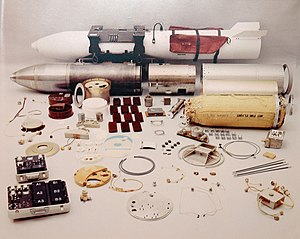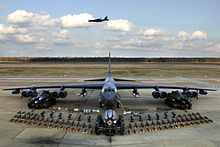B83 (nuclear weapon)
The B83 is a hydrogen bomb , which was constructed as a free-falling aerial bomb with a variably selectable explosive force . It entered service in 1983 and is currently the most powerful nuclear weapon in the United States' arsenal .
development
The B83 was created in response to a request by the United States Armed Forces in the 1970s. The B83 was intended to replace the older B28 , B43 and B53 bombs . These older bombs were not very flexible and there was cause for concern that these weapons could detonate unintentionally. A new bomb with high explosive power was required, which is suitable for a wide range of uses. As the primary application platforms were bombers from the Strategic Air Command provided. In the late 1970s, Lawrence Livermore National Laboratory began developing the B83. During the development of the B83, technologies and concepts from the never completed B77 program were used (including the W77 nuclear warhead). The B83 was tested from 1984–1985 as part of Operation Grenadier at the Nevada nuclear test site. The first models were delivered in 1983 and in 1984 the B83 was ready for use.
construction
bomb
The B83 has a streamlined bomb shell so that it can also be used by supersonic fighter aircraft (up to Mach 2). It can be carried in a weapon bay as well as at external load stations . For this, the B83 is equipped with the standard bomb locks with 762 mm. The B83 bomb can be roughly divided into three sections. Shock absorbers and the ignition systems are located in the top of the bomb. The central section houses the W83 nuclear warhead and its controls. Four stabilizing wings are mounted on the rear of the bomb. Parachutes / braking parachutes made of nylon / Kevlar are also housed in the bomb tail . The B83 bomb is 3.67 m long, 457 mm in diameter and weighs 1,089 kg. The actual nuclear warhead takes a length between 90 and 120 cm.
The B83 is designed to combat hardened targets such as underground bunkers and missile silos . It can also be dropped from low altitude, from an altitude of 45 m at a speed of Mach 1.2. For this purpose, three auxiliary parachutes / braking parachutes with a diameter of 1.20 m are triggered by a gas generator at the stern immediately after the bomb is dropped . These in turn pull the main parachute with a diameter of 14 m from the rear of the bomb. This means that the bomb can be braked to around 56 km / h within 2 seconds . Five concentric rings made of high-strength steel are attached to the top of the bomb . These are intended to prevent the bomb from ricocheting and sliding off when it hits flat concrete surfaces . Furthermore, these rings should transfer the impact energy to the bomb shell and the shock absorber inside the bomb. The shock absorbers consist of a deformation zone with a honeycomb structure made of aluminum. For dropping from great and medium heights (without a parachute), rotary engines are installed in the rear third of the bomb cover. The exhaust gases of the rotary engines emerge from nozzles which are arranged perpendicular to the longitudinal axis and tangential to the circumference of the bomb. This causes the bomb to rotate around its longitudinal axis, which stabilizes the fall. The nuclear warhead can be ignited by an impact fuse , a proximity fuse or a time fuse . The warhead can be ignited with a delay of up to 180 seconds, so that the carrier aircraft has enough time to move away from the area of impact of the nuclear weapon explosion.
Nuclear warhead
The nuclear warhead of the B83 is a hydrogen bomb based on the Teller-Ulam design . The B83 uses a boosted fission bomb in the primary nuclear fission explosive device (fission fuse) . This consists of a hollow sphere of 239 plutonium filled with deuterium - tritium gas . Above this there is a neutron reflector made of a layer of beryllium . For the detonation of this primary nuclear fission explosive device , explosive lenses with the polymer-bound explosive LX-17 are used. The fusion stage is located next to the spherical nuclear fission explosive device. A core made of 235 uranium, which is surrounded by lithium deuteride (with 6 Li), is used as a so-called spark plug . This is presumably in a mantle made of 238 uranium. The nuclear warhead is constructed in such a way that the explosive force can be selected in several stages, between an equivalent of a few kilotons of TNT up to a maximum explosive force of 1.2 MT TNT. The selection of the explosive force can take place both on the ground before the aircraft takes off or during transport on the carrier aircraft. The weapon is equipped with various safety systems such as the Permissive Action Link (PAL) type D and a Command Disablement System (CDS). Both are designed to prevent accidental detonation or improper use.
Mission concept
The B83 was primarily designed for a strategic deployment concept. Due to the different ignition systems and the optional parachute / braking parachute, the B83 can be used in a wide range of applications:
- free-falling height ignition (from a great height)
- Altitude ignition after delay by parachute (from high and medium altitude)
- free-falling impact ignition (from high and medium height)
- Impact ignition after delay by parachute (from high and medium height)
- delayed ignition after dropping from low flight ("laydown" drop)
- delayed ignition after dropping from the climb (pulling up from the low flight - "toss" or "loft" drop)
status
Originally the production of 1200 B83 was planned. With the end of the Cold War , production ceased after around 650 bombs. The B83 was also intended for use with the Robust Nuclear Earth Penetrator (RNEP) . The program was discontinued in 2005. In the longer term, the B83 is to be replaced by the B61-12 .
Emergency aircraft
- Grumman A-6 Intruder
- Vought A-7 Corsair II
- McDonnell Douglas AV-8B Harrier II
- Rockwell B-1 Lancer
- Northrop B-2 Spirit
- Boeing B-52 Stratofortress
- McDonnell Douglas F-15E Strike Eagle
- General Dynamics F-16 Fighting Falcon
- McDonnell Douglas F / A-18 Hornet
- Lockheed Martin F-22 Raptor
- General Dynamics F-111 Aardvark
literature
- Duncan Lennox: Jane's Strategic Weapon Systems . Edition 2001, 34th edition Edition, Jane's Information Group, 2001, ISBN 0-7106-0880-2 .


